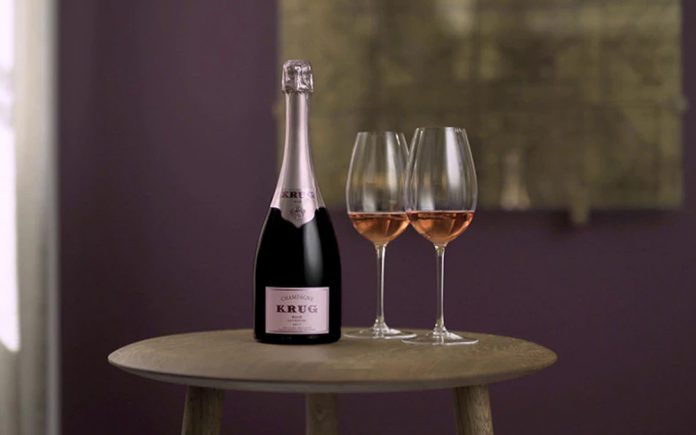
By Rick Riozza
There are probably three distinct times in which Rosé Champagne is particularly covered in wine publications: (1) Around Thanksgiving and Christmas—for obvious reasons: festive, fun, colorful and it’s the holidays! (2) Around St. Valentine’s Day—for obvious reasons: romantic, festive, and sensual; and (3) Just around mid-August when wine folks are desiring a delicious change from all of the refreshing white wine we’ve been dousing with to beat the heat. And a Rosé Champagne is the ticket.
Decanter Magazine recently wrote, “Rosé Champagnes are so widely available today that it’s hard to believe volume production is a relatively recent phenomenon. Just 15 years ago, rosé accounted for just 3% of total Champagne output – today the figure sits close to 15%. This reflects the increase in rosé wine consumption across the board and, within sparkling wine, Champagne leads the way as the source for the world’s best (and most expensive) pink wines.”
And as we always alert, by using the term “Champagne” we always mean the French stuff from the Champagne region of France. We know most folk generically refer to a sparkling wine as “Champagne”. And of course there are great sparkling wines from around the world—but, they’re legally not champagne.
And then we get to Rosé Champagnes which are often more expensive than white champagne because making it them more labor-intensive and time-consuming, and therefore, more costly to produce. The most common method for rosé sparkling wine is to blend non-sparkling red wine into the champagne.
The French rosé champagne approach is more difficult because it involves carefully limiting contact between the red skin and the juice during the part of fermentation called maceration (soaking the grapes in their own flesh, juice and skins to extract the colour, tannin and flavour compounds into the must or juice) to create the coveted pale salmon color known as oeil-de-perdrix or partridge eye. Wine made this way has a more delicate flavor. This is why the French rosé bubbly costs so much—because of production costs and the time it takes to make it, almost twice the time of the blanc.
I’ve spoken to a few French Champagne vintners throughout the years and they tell me that more-or-less, after all things and labor are considered, when it comes to rosé champagne, they only make about $12 an hour for their efforts. And that’s still includes the real pricey French stuff.
About 99 per cent of grape juice without any skin contact is a clear-greyish colour. The main challenge is to create the same color year after year even though the blend of grapes changes. Champagne houses pride themselves a consistent house style.
Veuve Cliquot has a separate winery to produce the pinot noir wines to blend into its rosé. Nicolas Feuillatte Palmes d’Or Rosé limits the red skin contact on the clear juice to create its rosé, a prestige cuvée that the winery positions as a tete de cuvée like Dom Pérignon or La Grande Dame.
And it doesn’t take a sophisticated palate to notice how delicious French rosé bubby actually is: dry, crisp delicate but with great body and mouthfeel. Its aromas of strawberries and raspberries pair well with duck, game and salmon. Lovers of red wines often prefer rosé and blanc de noirs over blanc de blancs champagnes.
And now—Decanter’s take on some wonderful French rosé bubbly to contemplate:
Krug, Grande Cuvée 24ème Rosé Edition, ($325) Believe it or not, at this price, it’s probably one of the best rosés in the multi-hundred-dollar price range. It’s everything one can imagine with fresh red fruits, light citrus, stone fruits with complexities of light forest nuance. It’s a treat for certain—for many a once in a lifetime experience, but worth it!
Laurent-Perrier, Cuvée Rosé, NV, Champagne, France, ($80)
The latest opus of Laurent Perrier’s non-vintage Brut Cuvée Rosé offers elegant and fresh aromas of red berries, blood orange, pomegranate and pastry. With ripe acids, the palate is tense, fine and chiselled, with a vinous texture with iodine and a salty finish.
Pommery, Brut Rosé Royal, Champagne, France, ($60)
A fine and fruity champagne, with a pretty blush pink color and scented nose of sweet strawberries. The palate is succulent and juicy, mouthwatering, with a delicious redcurrant, raspberry and lemon citrus zing. The texture is smooth with persistent bubbles.
Heidsieck & Co Monopole, Rosé Top, Champagne, France, ($50)
A delicate and delightfully fresh rose champagne dominated by strawberry, raspberry and lemon flavours with a hint of creaminess around the edges. Zesty and mouth-watering with persistent fine bubbles. This is a versatile pick, able to pair nicely with desserts as well as fish and pasta dishes.
Ruinart, Rosé, Champagne, France NV, ($70)
A blend of 55% Pinot Noir and 45% Chardonnay, and featuring around 25% reserve wines, this is 100% premier cru fruit from the Montagne des Reims and Côte des Blancs. Almost a third of the Pinot Noir was vinified as a still wine. A deep coral colour, this is fresh and youthful, with rounded wild red berry fruit, and hint of rose. With time in the glass, it develops deeper, complex, more exotic notes, leading to a long and lively finish.
Moët & Chandon, Rosé Impérial, Champagne, France NV, ($60) We cover this wine often in these pages. It’s always delicious, festive, and at a great price. The Corkery states, “The bouquet exudes strawberry, raspberry, and cherry with floral nuances. On the palate, the wine shows a juicy intensity of fresh berries, clear juicy strawberry, and culminates with the fleshiness of peach. The wine buzzes with brisk acidity. The finish brings some layers of complexity, and makes you salivate, leaving your palate wanting more.” Cheers!












































